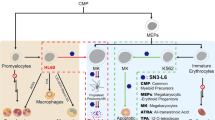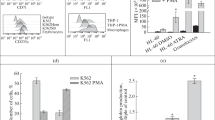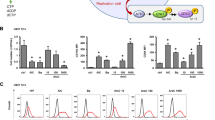Abstract
A slight induction of cellular differentiation (myelocytes and granulocytes) of HL-60 cells occurred after treatment with anti-tumor agents etoposide (VP-16), mitoxantrone (MXT), mitomycin C (MMC), actinomycin D (Act-D) or novobiocin (NOVO). Addition of sphinganine (SP), an inhibitor of protein kinase C (PKC) enhanced (2–3fold) the VP-16, MXT, MMC or Act-D-induced differentiation but not the NOVO-induced differentiation. No induction of differentiation was observed with 5-fluorouracil (5-FU) in the absence or presence of SP. The addition of SP in the fresh medium after the removal of VP-16, MXT, or MMC (0.5 h treatment) enhanced the induction of differentiation. In contrast, SP post-treatment did not have any effect on enhancing the differentiation which was induced by Act-D short exposure (0.5 h).
In an attempt to characterize the biochemical requirements for potentiation of VP-16-induced differentiation, we examined the effects of calcium depletion using calcium chelator ethylene glycol-bis(β-aminoethyl ether) N,N,N′,N′-tetraacetic acid (EGTA) or calcium channel blocker verapamil. Potentiation of VP-16-induced differentiation by SP was not observed in EGTA- or verapamiltreated cells. Calcium supplementation to the cells during the treatment with EGTA restored the SP-potentiation of VP-16-induced differentiation. Our results also showed that the induction of differentiation was accompanied by a decrease in PKC activity (70% of the control). PKC activity decreased to a greater extent (50% of control) in SP potentiation of differentiation induction.
Our results suggested that calcium-dependent biological action of antitumor agents and the inhibition of PKC activity are required for SP-potentiation of differentiation induction.
Similar content being viewed by others
References
Atsumi Y, Codd RC, Gray TK (1985) Calcium requirement for the lymphokine and vitamin D mediated differentiation of monoblastic U937 cells. Ann J Med Sci 289:47–50
Balazsovits JAE, Mayer LD, Bally MB, Cullis PR, Ginsberg RS, Falk RE (1989) Analysis of the effect of liposome encapsulation on the vesicant properties, acute and cardiac toxicities, and antitumor efficacy of doxorubicin. Cancer Chemother Pharmacol 23:81–86
Bertrand R, Kerrigan D, Sarang M, Pommier Y (1991) Cell death induced by topoisomerase inhibitors: role of calcium in mammalian cells. Biochem Pharmacol 42:77–85
Bradford MM (1976) A rapid and sensitive method for the quantitation of microgram quantities of protein utilizing the principle of protein-dye binding. Anal Biochem 72:248–254
Carter SK (1975) Adriamycin, a review. J Natl Cancer Inst 55:1265–1274
Collins SJ, Bonder A, Ting R, Gallo RC (1980) Induction of morphological and functional differentiation of human promyelocytic leukemia cells (HL-60) by compounds which induce differentiation of murine leukemia cells. Int J Cancer 25:213–218
Collins SJ, Ruscetti FW Gallagher RE, Gallo RC (1979) Normal functional characteristics of culture human promyelocytic leukemia cells (HL-60) after induction of differentiation by dimethylsulfoxide. J Exp Med 149:969–974
Constantinou A, Henning-Chubb C, Huberman E (1989) Novobiocinand phorbol-12-myristate-13-acetate-induced differentiation of human leukemia cells associated with a reduction in topoisomerase II activity. Cancer Res 49:1110–1117
Flynn PJ, Miller WJ, Weisdorf DC, Browning R, Branda RF (1983) Retinoic acid treatment of acute promyelocytic leukemia: in vitro and in vivo observations. Blood 62:1211–1217
Gellert M (1981) DNA topoisomerases. Ann Rev Biochem 50:879–910
Gold EJ, Mertelsman RH, Itri LM, Gee T, Arlin Z, Kempin S, Clarkson B, Moore MAS (1983) Phase I clinical trial of 13-cis-retinoic acid in myelodysplastic syndromes. Cancer Treat Rep 67:981–987
Hashimoto K, Kishimoto A, Aihara H, Yasuda I, Mikawa K, Nishizuka Y (1990) Protein kinase C during differentiation of human promyelocytic leukemia cell line, HL-60. FEBS Lett 263:31–34
Heidelberger C, Danenberg PV, Moran RG (1983) Fluorinated pyrimidines and their nucleosides. Adv Enzymol Relat Areas Mol Biol 54:58–119
von Hoff DD, Layard MW, Basa P, Davis HL, Von Hoff AL, Rozencweig M, Muggia FM (1979) Risk factors for doxorubicin-induced congestive heart failure. Ann Intern Med 91:710–717
Huang ME, Ye YC, Chen SR, Chai JR, Lu JX, Zhoa L, Gu LJ, Wang ZY (1988) Use of all — trans retinoic acid in the treatment of acute promyelocytic leukemia. Blood 72:567–572
Hui EKW, Yung BYM (1992) Protein kinase C activity during sphinganine potentiation of retinoic acid-induced differentiation in a human leukemia cell line (HL-60). Life Sci 51:415–422
Ijiri K (1989) Apoptosis (cell death) induced in mouse bowel by 1,2-dimethylhydrazine, methylazoxymethanol acetate, and gammarays. Cancer Res 49:6342–6346
Koeffler HP (1983) Induction of differentiation of human acute myelogenous leukemia cells: therapeutic implications. Blood 62: 709–721
Kretsinger HR (1979) The informational role of calcium in cytosol. Adv Cyclic Nucleotide Res 11:1–26
Levenson R, Housman D, Cantley L (1980) Amiloride inhibits murine erythroleukemia cell differentiation: evidence for a calcium requirement for commitment. Proc Natl Acad Sci USA 77:5948–5952
Lippman SM, Kessler JF, Meyskens FL Jr (1987) Retinoids as preventive and therapeutic anticancer agents (part 1). Cancer Treat Rep 71:391–405
Marx JL (1987) Human trials of new cancer therapy begin. Scienc (Washington DC) 236:778–779
Miyaura C, Abe E, Suda T (1984) Extracellular calcium is involved in the mechanism of differentiation of mouse myeloid leukemia cells (M1) induced by 1α,25-dihydroxyvitamin D3. Endocrinology 115:1891–1896
Nakaya K, Chou S, Kaneko M, Nakamura Y (1991) Topoisomerase inhibitors have potent differentiation-inducing activity for human and mouse myeloid leukemia cells. Jpn J Cancer Res 82:184–191
Okazaki T, Mochizuki T, Tashima M, Sawada T, Uchino H (1986) Role of intracellular calcium ion in human promyelocytic leukemia HL-60 cell differentiation. Cancer Res 46:6059–6063
Olsson I, Gullberg U, Ivhed I, Nilsson K (1983) Induction of differentiation of the human histocytic lymphoma cell line U-937 by 1α,25-dihydroxycholecalciferol. Cancer Res 43:5862–5867
Rappa G, Lorico A, Sartorelli AC (1990) Induction of differentiation of WEHI-3B D+ monomyelocytic leukemia cells by inhibitors of topoisomerase II. Cancer Res 50:6723–6730
Rasmussen H (1970) Cell communication, calcium ion, and cyclic adenosine monophosphate. Science (Washington DC) 170:404–412
Smith CA, Williams GT, Kingston R, Jenkinson EJ, Owen JJT (1989) Antibodies to CD3/Tcell receptor complex induce death by apoptosis in immature T cells in thymic cultures. Nature (Lond) 337:182–183
Stevens VL, Winton EF, Smith EE, Owen NE, Kinkade JM Jr, Merrill AH Jr (1989) Differentiation effects of long-chain (sphingoid) bases on the monocytic differentiation of human leukemia (HL-60) cells induced by phorbol ester, 1α, 25-dihydroxyvitamin D3, of ganglioside GM3. Cancer Res 49:3229–3234
Stevens VL, Owens NE, Winton EF, Kinkade JM Jr, Merrill AH Jr (1990) Modulation of retinoic acid-induced differentiation of human leukemia (HL-60) cells by serum factors and shinganine. Cancer Res 50:222–226
Tewey KM, Rowe TC, Yang L, Halligan BD, Liu LF (1984) Adriamycin-induced DNA damage mediated by mammalian DNA topoisomerase II. Science (Washington DC) 226:466–468
Thomas TP, Gopalakrishna R, Anderson WB (1987) Hormone- and tumor promote-induced activation or membrane association of protein kinase C in intact cells. Methods Enzymol 141:399–411
Trask DK, Moller MT (1988) Stabilization of type I topoisomerase-DNA covalent complexes by actinomycin D. Proc Natl Acad Sci USA 85:1417–1421
Trauth C, Klas C, Peters AMJ, Matzku S, Moller P, Fal W Debatin KM, Krammer PH (1989) Monoclonal antibody-mediated tumor regression by induction of apoptosis. Science (Washington DC) 245:301–305
Tsiftsoglou AS, Robinson SH (1985) Differentiation of leukemia cell lines: A review focusing on murine erythroleukemia and human HL-60 cells. Int J Cell Cloning 3:349–366
Wang JJ, Chervinsky DS, Rosen JM (1972) Comparative biochemical studies of adriamycin and daunomycin in leukemia cells. Cancer Res 32:511–515
Whitfield JF, Boynton AL, MacManus JP, Rixon RH, Sikorska M, Tsang B, Walker PR (1980) The role of calcium and cyclic AMP in cell proliferation. Ann NY Acad Sci 339:216–240
Yung BYM, Bor AMS, Chan PK (1990) Short exposure to actinomycin D induces “reversible” translocation of protein B23 as well as “reversible” inhibition of cell growth and RNA synthesis in HeLa cells. Cancer Res 50:5987–5991
Yung BYM, Luo KJ, Hui EKW (1992) Interaction of antileukemia agents adriamycin and daunomycin with sphinganine on the differentiation of human leukemia cell line HL-60. Cancer Res 5:3593–3597
Author information
Authors and Affiliations
Additional information
This work was supported by Chang Gung Research Grant CMRP 352 and National Science Council (R.O.C.) Grants NSC 81-0412-B-182-41 and NSC 82-0412-B-182-006
Rights and permissions
About this article
Cite this article
Yat-Ming Yung, B. Sphinganine potentiation of cellular differentiation induced by various anti-leukemia drugs in human leukemia cell line HL-60. Naunyn-Schmiedeberg's Arch Pharmacol 350, 575–581 (1994). https://doi.org/10.1007/BF00173029
Received:
Accepted:
Issue Date:
DOI: https://doi.org/10.1007/BF00173029




